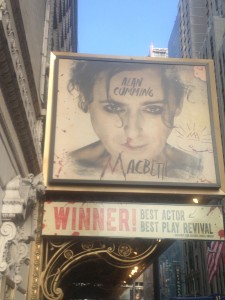 This One-Scot Show was my end-of-semester treat, and this poster gets it right, if hitting the spot means catching you between the eyes. The production interwove an inventive performance by Cumming that only occasionally slipped into caricature — mainly in his whining, petulant child-king Duncan — against a spare institutional backdrop. The performance opened in silence, as a female doctor and husky male orderly medicated Cumming and changed him into a hospital gown. He clutched a paper bag labelled “Evidence” that will eventually reveal a child’s sweater, later appropriated to play the part of Macduff’s doomed son. Concerned faces on the medical personnel implied that the patient might at any time explode, implode, or scatter his bloody fragments about the stage. (But we know that already from Shakespeare.) The first lines spoken were also the first lines in Macbeth, but they worked doubly, referring both to the Weird Sisters and to the institutional trio — patient, doctor, orderly — who are the only figures on stage:
This One-Scot Show was my end-of-semester treat, and this poster gets it right, if hitting the spot means catching you between the eyes. The production interwove an inventive performance by Cumming that only occasionally slipped into caricature — mainly in his whining, petulant child-king Duncan — against a spare institutional backdrop. The performance opened in silence, as a female doctor and husky male orderly medicated Cumming and changed him into a hospital gown. He clutched a paper bag labelled “Evidence” that will eventually reveal a child’s sweater, later appropriated to play the part of Macduff’s doomed son. Concerned faces on the medical personnel implied that the patient might at any time explode, implode, or scatter his bloody fragments about the stage. (But we know that already from Shakespeare.) The first lines spoken were also the first lines in Macbeth, but they worked doubly, referring both to the Weird Sisters and to the institutional trio — patient, doctor, orderly — who are the only figures on stage:
When shall we three meet again?
Some reviewers found the constant shuttling among different characters distracting, and it clearly confused at least a few of the chattering people sitting near me in the theater. There were some over-flashy touches, like the rapid-towel shifting that switched from Lady Macbeth — torso covered — to Macbeth — naked to the waist — but in general Cumming gave an engaging performance and has a great, clear, Scottish voice. The shifts were disorienting enough to draw attention away from some powerful speechs, especially early in the performance, but others took on new force:
Is this a dagger which I see before me?
 The backdrop of mental illness made the hero somewhat less than awe-ful in both the ethical and purely theatrical senses. I can’t agree with Ron Rosenbaum that this production provided unique insight into the nature of evil, but by performing the play as a kind of auto-investigation, self-generated therapy or protest against therapeutic invasion, it does show off the paranoid closeness of perhaps Shakespeare’s most hero-centric play. The super-warrior who unseams his enemies from the nave to the chops isn’t much in evidence, but Cumming’s mad, obsessed figure, dragging himself from bed to bathtub to sink, always aware of the overlooking eyes of his attendants and their three video camera-witches, provided menace and danger. He also became, perhaps because he’s the only person to look at much of the time, powerfully sympathetic, in a slightly disjointed, almost Beckettian way.
The backdrop of mental illness made the hero somewhat less than awe-ful in both the ethical and purely theatrical senses. I can’t agree with Ron Rosenbaum that this production provided unique insight into the nature of evil, but by performing the play as a kind of auto-investigation, self-generated therapy or protest against therapeutic invasion, it does show off the paranoid closeness of perhaps Shakespeare’s most hero-centric play. The super-warrior who unseams his enemies from the nave to the chops isn’t much in evidence, but Cumming’s mad, obsessed figure, dragging himself from bed to bathtub to sink, always aware of the overlooking eyes of his attendants and their three video camera-witches, provided menace and danger. He also became, perhaps because he’s the only person to look at much of the time, powerfully sympathetic, in a slightly disjointed, almost Beckettian way.
It will have blood, they say. Blood will have blood.
The most powerful prop on stage was a large doll, dressed in pink, that stood for baby-prince Malcolm, named heir to boy-king Duncan. Without engaging over-much in extra-textual speculations of the sort mocked in the famous essay, “How Many Children Had Lady Macbeth?” I kept thinking that the emotional core of this production wasn’t so much vaulting ambition or shared lust for power but a fundamental rage against the Child and the futurity that children represent. (Does Lee Edelman talk about Macbeth in No Future? He did recently write a great essay on Hamlet.) When the doll gets propped up on the wheelchair-throne for the final tableau, it’s hard not to feel that Macbeth’s death — the conflict with Macduff ends with “him” drowned in the bathtub, where Macduff’s sweater-son had also been immersed — marks the triumph of an infant’s future over an adult’s present.
How does your patient, doctor?
Addressed to the female doctor who has returned to the stage, this line, like the performance’s opening line, works both within the theatrical frame and in Shakespeare’s play. It also edges toward the death of Lady Macbeth, often the emotional high point of the play. The last great Macbeth I saw, by Cheek by Jowl in 2011, had me wanting a production of just the love story, with no one on stage but Him and Her. Cumming’s performance of the marriage was quite strong — he did slightly overdo some of the sexual impersonation jokes when Lady Macbeth read her letter in the bath, and the inventive staging of her seducing her husband into the murder seemed to rely on a sophomoric reading of the line, “Screw your courage to the sticking point.” The central loss or crime or catastrophe in the ambiguous frame story seemed to involve a child, but Lady Macbeth, and the concerned, sympathetic female doctor, were somehow at the heart of it too.
…full of sound and fury, / Signifying…signifying…signifying…nothing.
Certain lines in Shakespeare are too over-familiar to be performed easily. At times Cumming’s soliloquies, in particular, suffered from their clear, direct enunciation: we know the words already, I wanted to say, what else can you do? (Sometimes I think I’m not the intended audience for Shakespeare on Broadway.) Probably the most interesting twist on a canonical phrase was Cumming’s triple-take on what follows sound and fury. He struggled and stopped three times before getting to “nothing,” as if he couldn’t quite get through it, couldn’t quite accept his wife’s off-stage death, his pronouncement of an absurdist universe, the rounding close of the play itself. What comes before nothing?
 In the end Cumming’s production stayed, of necessity, within one head. It was propelled by rage of the present against the future, the desire never to cede the stage, not to be displaced —
In the end Cumming’s production stayed, of necessity, within one head. It was propelled by rage of the present against the future, the desire never to cede the stage, not to be displaced —
If it ’twere done, when ’tis done, ’twere well
It were done quickly…
We watched on the video feed as the hero held himself underwater in the bath where young Macduff had been drowned. He couldn’t hold out, and emerged with a splash. Exhausted, avoiding the enthroned doll at center stage, he dragged himself back to his hospital bed. He looked up at the doctor.
When shall we three meet again?
A great performance of the theatrical “now,” packed into a scant 100 minutes. The sun was going down as I left the Barrymore Theater.
Leave a Reply